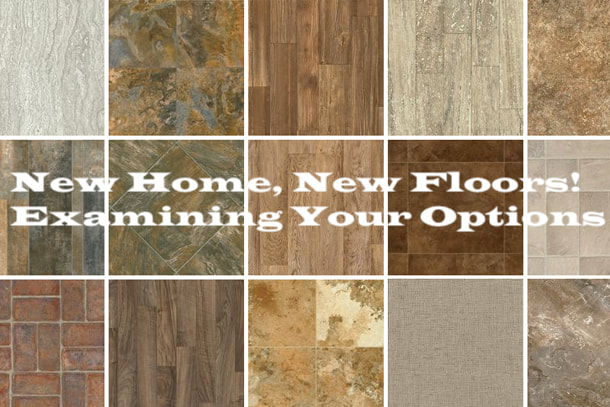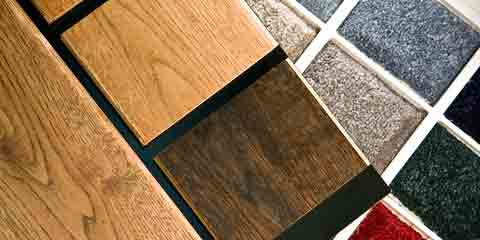It’s gotta go.
Your bedroom carpet is pretty hairy, too, but your agent assured you that these things are fairly easy to deal with, especially if you have the flooring replaced before you start moving in. And it’s true, replacing flooring is easy. Choosing the new flooring, well, that’s tough.
Your Flooring Options: A Journey UnderfootWhether you’ve owned your house for a day, a year or a decade, picking the flooring you’re going to have to live with for a while can be stressful. There are so many materials available and within those, a huge array of colors and designs. It’s the paradox of choice at work, you have so many options you may literally freeze. That’s why we’re going to break it down for you, in hopes that the overwhelm is minimized when your time comes.
Next time you’re in the mood to look at flooring patterns online or in your home improvement stores, here are some things to consider about the most common flooring options available.
Carpet
The fuzzy stand-by for living areas and bedrooms, wall-to-wall carpet has been a popular flooring choice for a century. The materials may have changed, but the basic configuration is the same. All carpets are just a series of fibers woven onto a flexible grid, topping a uniformly thick padding.
When choosing a carpet, look for one with a face weight of at least 30 ounces. These are just above builder grade and should last six to 12 years. Always choose the best mid-grade carpet you can afford, you can’t go wrong that way. It’s where value and durability meet. Don’t skimp on carpet pad, either. Let the carpet shop match a pad to the carpet you’ve chosen so that you get the most life out of them both.
- Best places for carpet in your home:
- – Bedrooms
- – Living rooms (excluding the traffic zones)
- – Offices
- – Formal living rooms
- – Dens
Today’s tile comes in a huge range of colors, shapes, sizes and materials, but it all shares one thing in common: it’s nearly indestructible when installed properly and should be considered a permanent decision. It’s not that you can’t untile your entryway, but it’s going to be a difficult job, so take this decision carefully and skip the trendy stuff.
There are several grades of tile, but in general, they’re divided into two camps: wall tile and floor tile. While you can use floor tile on the wall with the right adhesive and a lot of patience, you should never use wall tile on the floor. It’s simply not hard enough and will end up cracking or otherwise failing.
The other major consideration is your floor. Is it a perfectly smooth, flat floor, or does it have some minor bumps and ridges? Even minor settling needs to be kept in mind when you’re choosing a tile size. Small tiles are far more forgiving of uneven floors than huge tiles. When a tile doesn’t make full contact with the mortar bed, it will come loose, then others will follow.
Popping tiles can become a major problem in older homes that are built on crawl spaces or basements, and although there’s a certain amount of compensation offered by cement board, it’s just better to hedge your bets by choosing smaller tiles.
- Best places for tile in your home:
- – High traffic areas
- – Kitchens
- – Bathrooms
- – Dining rooms
- – Mudrooms
- – Laundry rooms
- – Sunrooms
Wood floors are timeless and sturdy, and these days, come in both solid wood and engineered formats. Solid wood floors will give you a floor that’s more or less just like those floors of yesteryear, completely seamless and total class all the way. Many people choose prefinished wood floors to make installation easier, but unfinished wood floors are still available and make a vibrant, albeit expensive, statement.
Engineered wood floors, on the other hand, are made from layers of wood and plywood. They look just like finished solid wood floors, but are not as durable overall. Most people won’t be able to tell the difference, however, and engineered wood floors can perform better than solid wood floors in wet places, so you’ll just have to strike a balance between your needs and the materials that are available.
- Best places for wood flooring in your home:
- – Living room
- – Bedroom
- – Dining room
- – Staircases
- – Entryways
- – Offices
- – Kitchens (engineered, with proper precautions)
Laminate flooring is a very durable, flexible and affordable hard surface for all sorts of homes and situations. Like engineered wood flooring, it consists of several layers of material, including a clear wear layer, a design layer that can simulate wood, stone and a variety of other patterns, an inner core that provides the majority of the structural stability of the product and a backing layer that helps to protect from warpage.
Unlike a wood floor, laminate floors are installed without glue or nails, which is why some people still refer to them as “floating floors.” They don’t actually float, but walking on one for the first time can be interesting if you’re very sensitive to that sort of thing (many of them are also very slick, just something to keep in mind). Because the material is designed as tongue and groove boards, everything fits tightly as your jigsaw puzzle of a floor is constructed. When it’s done, all that’s required to hold it in place is properly installed trim.
It’s an easy floor. In fact, this is one flooring option you might even want to DIY if you’re the handy type.
- Best places for laminate flooring in your home:
- – Living room
- – Bedrooms
- – Bathrooms (choose one that’s water resistant)
- – Kitchen
- – Foyer
- – Office
- – Pretty much anywhere
It wasn’t that long ago that vinyl flooring meant tired patterns on reliable, but boring sheet material that had to be painstakingly glued to the floor. One bubble, one wrong cut, and the whole install might be ruined. Today’s vinyl is anything but fussy, with sturdier and more attractive tiles, planks and glue-free sheet goods. Vinyl is also an affordable solution that can be DIYed fairly easily.
It’s naturally water-resistant, making it a great match for basements and places that get damp. Unlike many other types of non-carpet floorings, however, vinyl can be fairly soft, so if you’re putting it in an area like a dining room, you’ll have to take a lot of care not to gouge it when you’re moving chairs under the table. Overall, vinyl provides a good bang for your buck, and since it’s time-tested, you know exactly what you can expect from it: a long, useful life provided you give it the minimal care it needs.
- Best places for vinyl flooring in your home:
- – Kitchen
- – Laundry room
- – Basement
- – Mudroom
- – Foyer
Time to Get Your Flooring On! Now that you know what your flooring options are, it’s time to get shopping. Even if you’re not confident in your flooring installation skills, you can still pick out the patterns and materials you want to use in your home. Let me know if you'd like some referrals for a great flooring contractor in your area!





 RSS Feed
RSS Feed